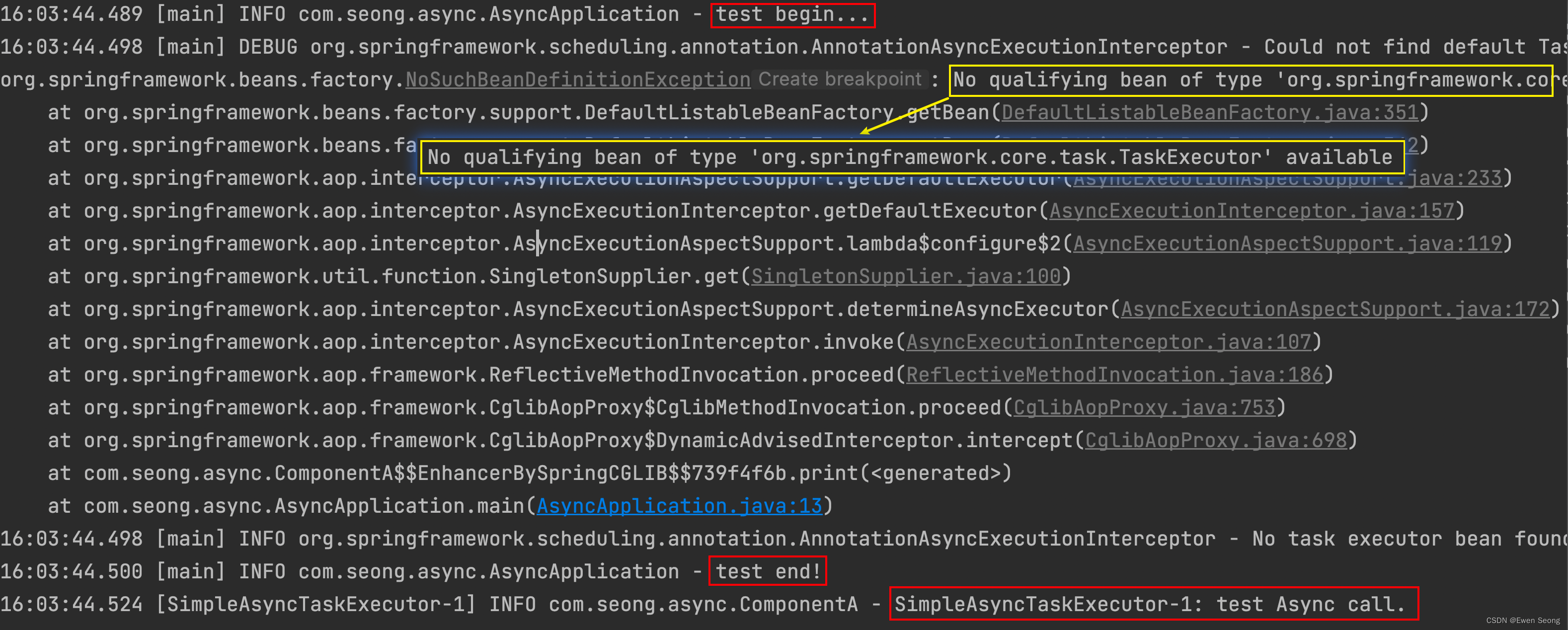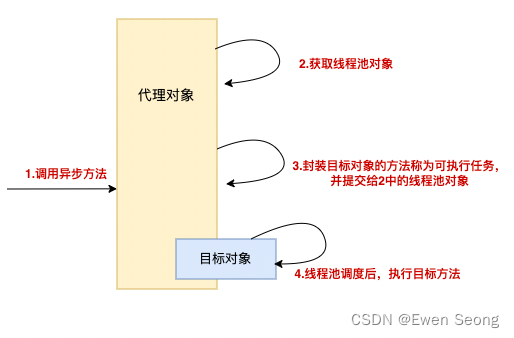赤峰市做网站建设的公司上海的重大新闻
背景:
本文作为Spring系列的第九篇,介绍@Async注解的使用、注意事项和实现原理,原理部分会结合Spring框架代码进行。
本文可以和Spring系列-8 AOP原理进行比较阅读
1.使用方式
@Async一般注解在方法上,用于实现方法的异步:方法调用者立即返回,待调用的方法提交给Spring的线程池执行。@Async也可以注解在类上,等价于在类中的所有方法上添加该注解。需要注意@Async只对Spring管理的对象生效。
案例介绍:
1.1 基本用例
在配置类或者启动类上注解@EnableAsync,用于开启异步功能:
@Configuration
@ComponentScan(basePackages = "com.seong.async")
@EnableAsync
public class AsyncConfiguration {
}
在方法上添加@Async注解:
package com.seong.async;@Component
public class ComponentA {@Asyncpublic void print() {System.out.println(Thread.currentThread().getName()+":"+" test Async call.");}
}
用例如下:
@Slf4j
public class AsyncApplication {public static void main(String[] args) {AnnotationConfigApplicationContext applicationContext = new AnnotationConfigApplicationContext(AsyncConfiguration.class);//用id取出业务逻辑类的beanComponentA componentA = (ComponentA) applicationContext.getBean("componentA");LOGGER.info("test begin...");componentA.print();LOGGER.info("test end!");}
}
得到如下结果:

结果显示:ComponentA对象的print()方法被异步执行了,且DEBUG日志抛出了No qualifying bean of type 'org.springframework.core.task.TaskExecutor' available异常;这是因为业务代码没有配置TaskExecutor类型的Bean对象导致。
1.2 配置线程池
被@Async注解的方法会提交给线程池执行,这里可以手动指定线程池或者使用默认的线程池:
(1) 手动指定线程池:
通过Async的value属性指定线程池Bean对象(通过beanName指定),如:
@Component
public class ComponentA {@Async("myTaskExecutor")public void print() {System.out.println(Thread.currentThread().getName()+":"+" test Async call.");}
}@Configuration
@EnableAsync
public class AsyncConfiguration {@Beanpublic Executor myTaskExecutor() {return Executors.newFixedThreadPool(1);}
}
此时,运行任务会提交给"myTaskExecutor"线程池对象执行。
(2) 配置默认的线程池:
@Bean
public TaskExecutor myTaskExecutor() {return new SimpleAsyncTaskExecutor();
}
Spring为@Async提供了默认线程池配置,可通过向IOC中注册TaskExecutor类型的Bean对象实现。
也可使用如下配置注册默认线程池:
@Bean
public Executor taskExecutor() {return Executors.newFixedThreadPool(1);
}
Spring框架获取TaskExecutor类型的Bean对象失败时,会尝试获取BeanName为"taskExecutor"的线程池对象;但执行时日志中会给出异常信息。
(3) 使用Spring框架默认的SimpleAsyncTaskExecutor线程池.
若业务未配置默认线程池,默认使用Spring生成的SimpleAsyncTaskExecutor对象; 但执行时日志中会给出异常信息。
1.3 获取返回值
由于@Async注解的方法为异步执行,因此可以通过Future来获取返回值,案例如下:
修改ComponentA的方法:
@Component
@Slf4j
public class ComponentA {@Asyncpublic Future<String> print() {LOGGER.info(Thread.currentThread().getName() + ":" + " test Async call.");return new AsyncResult<>("ComponentA finished.");}
}
适配修改案例:
@Slf4j
public class AsyncApplication {public static void main(String[] args) throws ExecutionException, InterruptedException {AnnotationConfigApplicationContext applicationContext = new AnnotationConfigApplicationContext(AsyncConfiguration.class);ComponentA componentA = (ComponentA) applicationContext.getBean("componentA");LOGGER.info("test begin...");final Future<String> resultFuture = componentA.print();doOtherBusiness();LOGGER.info("test end!");// 这一步执行时main线程会等待异步方法返回的结果LOGGER.info("result is {}", resultFuture.get());}private static void doOtherBusiness() {LOGGER.info("do other business...");}
}
运行得到如下结果:

2.原理:
本质上Async注解的实现依赖于动态代理,代理过程中将任务提交给线程池,存在以下流程:

如上图所示,Spring为使用Async注解Bean对象生产一个动态代理对象,当Async注解的方法被调用时,会进入代理流程,选择线程池、封装调用逻辑并提交给线程池执行,返回执行结果。
注意:未被@Async注解的方法则不会执行上述流程(static方法也不会)
由于异步的本质是基于代理实现,所以同一个类中的方法调用会导致被调用方的异步作用失效,该场景与Spring的事务失效原因相同,可参考:事务-1 事务隔离级别和Spring事务传播机制.
2.1 EnableAsync注解:
2.1.1 EnableAsync注解定义
@EnableAsync注解核心作用是向容器中注册AsyncAnnotationBeanPostProcessor对象。
@Target(ElementType.TYPE)
@Retention(RetentionPolicy.RUNTIME)
@Documented
@Import(AsyncConfigurationSelector.class)
public @interface EnableAsync {Class<? extends Annotation> annotation() default Annotation.class;boolean proxyTargetClass() default false;AdviceMode mode() default AdviceMode.PROXY;int order() default Ordered.LOWEST_PRECEDENCE;
}
@EnableAsync注解提过了以下属性用于自定义配置:
[1] annotation属性:
用于指定生效的注解,默认为@Async和EJB的@Asynchronous注解。当指定注解时,仅指定的注解生效:
@Target({ElementType.TYPE, ElementType.METHOD})
@Retention(RetentionPolicy.RUNTIME)
@Documented
public @interface TestAnnotation {
}@EnableAsync(annotation = TestAnnotation.class)
public class AsyncConfiguration {
}@TestAnnotation
public void print() {System.out.println(Thread.currentThread().getName() + ":" + " test Async call");
}
但是,仅@Async中可以通过value属性指定需要的线程池Bean对象;因为硬编码获取beanName的逻辑:来源必须为@Async注解的value属性:
protected String getExecutorQualifier(Method method) {Async async = AnnotatedElementUtils.findMergedAnnotation(method, Async.class);if (async == null) {async = AnnotatedElementUtils.findMergedAnnotation(method.getDeclaringClass(), Async.class);}return (async != null ? async.value() : null);
}
[2] proxyTargetClass属性:
可用于配置代理类型:true时表示强制使用CGLIB动态代理,false时表示根据被代理类情况进行确定,默认为false。仅当模式设置为AdviceMode#PROXY时有效。
[3] mode属性:
指出应该如何应用异步通知, 默认值是AdviceMode.PROXY。
[4] order属性:
指示应该Bean对象在BPP阶段应用AsyncAnnotationBeanPostProcessor的顺序,默认值是Ordered.LOWEST_PRECEDENCE,以便在所有其他后处理器之后运行,这样它就可以向现有代理添加一个advisor而不是双代理。
2.1.2 EnableAsync注解作用
通过@Import注解向IOC中注入了AsyncConfigurationSelector对象, 进入AsyncConfigurationSelector对象:
public final String[] selectImports(AnnotationMetadata importingClassMetadata) {//...AdviceMode adviceMode = attributes.getEnum(getAdviceModeAttributeName());String[] imports = selectImports(adviceMode);//...return imports;
}public String[] selectImports(AdviceMode adviceMode) {switch (adviceMode) {case PROXY:// @EnableAsync注解的mode属性的默认值为AdviceMode.PROXYreturn new String[] {ProxyAsyncConfiguration.class.getName()};case ASPECTJ:return new String[] {ASYNC_EXECUTION_ASPECT_CONFIGURATION_CLASS_NAME};default:return null;}
}由于加载的AsyncConfigurationSelector对象为ImportSelector类型,Spring继续完成ProxyAsyncConfiguration类型的注入。
进入ProxyAsyncConfiguration代码逻辑,发现是一个配置类,用于向容器中注入一个AsyncAnnotationBeanPostProcessor对象:
@Configuration
@Role(BeanDefinition.ROLE_INFRASTRUCTURE)
public class ProxyAsyncConfiguration extends AbstractAsyncConfiguration {@Bean(name="org.springframework.context.annotation.internalAsyncAnnotationProcessor")@Role(BeanDefinition.ROLE_INFRASTRUCTURE)public AsyncAnnotationBeanPostProcessor asyncAdvisor() {AsyncAnnotationBeanPostProcessor bpp = new AsyncAnnotationBeanPostProcessor();bpp.configure(this.executor, this.exceptionHandler);Class<? extends Annotation> customAsyncAnnotation = this.enableAsync.getClass("annotation");if (customAsyncAnnotation != AnnotationUtils.getDefaultValue(EnableAsync.class, "annotation")) {bpp.setAsyncAnnotationType(customAsyncAnnotation);}bpp.setProxyTargetClass(this.enableAsync.getBoolean("proxyTargetClass"));bpp.setOrder(this.enableAsync.<Integer>getNumber("order"));return bpp;}
}
总之,@EnableAsync后IOC容器中会增加一个AsyncAnnotationBeanPostProcessor类型的对象;beanName为"org.springframework.context.annotation.internalAsyncAnnotationProcessor".
2.2 AsyncAnnotationBeanPostProcessor:
AsyncAnnotationBeanPostProcessor是一个后置处理器且实现了BeanFactoryAware接口,核心逻辑在两处:Aware阶段和BPP-After阶段.
[1] Aware阶段:准备好Advisor对象(内部包含一个拦截器)
public void setBeanFactory(BeanFactory beanFactory) {super.setBeanFactory(beanFactory);// 构造AsyncAnnotationAdvisor对象,注入到this.advisor属性中AsyncAnnotationAdvisor advisor = new AsyncAnnotationAdvisor(this.executor, this.exceptionHandler);advisor.setBeanFactory(beanFactory);this.advisor = advisor;
}上述方法完成了BeanFactory属性的注入以及this.advisor属性的设置,属性类型为AsyncAnnotationAdvisor,进入AsyncAnnotationAdvisor的构造函数:
public AsyncAnnotationAdvisor( executor, exceptionHandler) {this.advice = buildAdvice(executor, exceptionHandler);this.pointcut = buildPointcut(asyncAnnotationTypes);
}protected Advice buildAdvice( executor, exceptionHandler) {AnnotationAsyncExecutionInterceptor interceptor = new AnnotationAsyncExecutionInterceptor(null);// 设置线程池和异常处理器interceptor.configure(executor, exceptionHandler);return interceptor;
}注意AnnotationAsyncExecutionInterceptor是一个MethodInterceptor接口的实现类:
// MethodInterceptor拦截器接口的invoke方法
public Object invoke(final MethodInvocation invocation) throws Throwable {//...
}
总之,在aware阶段为AsyncAnnotationBeanPostProcessor对象注入this.advisor一个AsyncAnnotationAdvisor类型的对象,该对象包含BeanFactory和advice属性;其中advice属性包含一个MethodInterceptor拦截器。
[2] BPP-After阶段:为Bean对象生成代理
在AsyncAnnotationBeanPostProcessor的初始化过程完成后,当IOC初始化单例Bean对象时,会在初始化的后置处理器阶段调用AsyncAnnotationBeanPostProcessor的postProcessAfterInitialization方法:
@Override
public Object postProcessAfterInitialization(Object bean, String beanName) {// this.advisor在AsyncAnnotationBeanPostProcessor构建阶段已设值if (this.advisor == null || bean instanceof AopInfrastructureBean) {return bean;}// 是否已进行了AOP代理if (bean instanceof Advised) {Advised advised = (Advised) bean;if (!advised.isFrozen() && isEligible(AopUtils.getTargetClass(bean))) {// Add our local Advisor to the existing proxy's Advisor chain...if (this.beforeExistingAdvisors) {advised.addAdvisor(0, this.advisor);}else {advised.addAdvisor(this.advisor);}return bean;}}// 类中是否注解了@Asyncif (isEligible(bean, beanName)) {// 将bean对象存在了targetSource属性中,以便后续取用ProxyFactory proxyFactory = prepareProxyFactory(bean, beanName);if (!proxyFactory.isProxyTargetClass()) {evaluateProxyInterfaces(bean.getClass(), proxyFactory);}proxyFactory.addAdvisor(this.advisor);customizeProxyFactory(proxyFactory);return proxyFactory.getProxy(getProxyClassLoader());}return bean;
}如上述代码所示:
已完成AOP代理的不需要再次代理,将AsyncAnnotationBeanPostProcessor的this.advisor属性添加到代理对象的List<Advisor>列表中;未经过代理且类中注解了@Async的对象,Spring为其创建一个代理对象,并将this.advisor属性信息保存到代理对象中。【代理过程参考:Spring系列-8 AOP原理】
【3】接口调用
Spring提供了两种代理方式:JDK动态代理和CGLIB代理,由于底层代理细节对实现原理并无影响,这里以JDK动态代理为例进行介绍。
被代理的对象在方法被调用时,进入JdkDynamicAopProxy的invoke拦截方法,注意每个代理对象对应一个JdkDynamicAopProxy对象。
[插图:解释ProxyFactory、ProxyConfig、Advised的关系,以及JdkDynamicAopProxy的传参路径]
涉及代码如下所示(保留主线逻辑):
public Object invoke(Object proxy, Method method, Object[] args) throws Throwable {// hash/equals/toString check...TargetSource targetSource = this.advised.targetSource;Object target = targetSource.getTarget();Class<?> targetClass = (target != null ? target.getClass() : null);// 根据方法和字节码对象获取调用链,如果该方法未被@Async注解,则返回的集合为空;否则返回一个包含AnnotationAsyncExecutionInterceptor对象的单元素集合。List<Object> chain = this.advised.getInterceptorsAndDynamicInterceptionAdvice(method, targetClass);Object retVal;if (chain.isEmpty()) {Object[] argsToUse = AopProxyUtils.adaptArgumentsIfNecessary(method, args);// 直接用过反射调用目标方法retVal = AopUtils.invokeJoinpointUsingReflection(target, method, argsToUse);} else {MethodInvocation invocation =new ReflectiveMethodInvocation(proxy, target, method, args, targetClass, chain);retVal = invocation.proceed();}// 返回结果类型校验...return retVal;
}
invoke方法的主线逻辑:
[1] 从targetSource属性中取出被代理的对象;
[2] 从 advised属性中获取拦截器链;
[3] 判断拦截器链是否为空,为空则直接通过反射调用该方法;否则进入拦截器对象;
[4] 进行结果类型的校验,并返回结果对象。
ReflectiveMethodInvocation介绍:
ReflectiveMethodInvocation是对调用链进行的一层封装:
public Object proceed() throws Throwable {// We start with an index of -1 and increment early.if (this.currentInterceptorIndex == this.interceptorsAndDynamicMethodMatchers.size() - 1) {return invokeJoinpoint();}Object interceptorOrInterceptionAdvice =this.interceptorsAndDynamicMethodMatchers.get(++this.currentInterceptorIndex);return ((MethodInterceptor) interceptorOrInterceptionAdvice).invoke(this);
}interceptorsAndDynamicMethodMatchers为构建ReflectiveMethodInvocation对象时传入的chain参数;即依次调用拦截器的拦截invoke方法,最后执行invokeJoinpoint()方法。
注意:调用拦截器时将this作为入参(该ReflectiveMethodInvocation对象),拦截器中可通过调用该对象的proceed()实现回调。
2.3 AnnotationAsyncExecutionInterceptor介绍:
当异步方法被调用时,堆栈逻辑进入到AnnotationAsyncExecutionInterceptor的invoke方法:
public Object invoke(final MethodInvocation invocation) throws Throwable {Class<?> targetClass = (invocation.getThis() != null ? AopUtils.getTargetClass(invocation.getThis()) : null);Method specificMethod = ClassUtils.getMostSpecificMethod(invocation.getMethod(), targetClass);final Method userDeclaredMethod = BridgeMethodResolver.findBridgedMethod(specificMethod);// 1.确定待执行的任务的线程池AsyncTaskExecutor executor = determineAsyncExecutor(userDeclaredMethod);// 2.封装执行逻辑成一个任务Callable<Object> task = () -> {try {// 回调ReflectiveMethodInvocation的proceed方法Object result = invocation.proceed();if (result instanceof Future) {return ((Future<?>) result).get();}}catch (ExecutionException ex) {handleError(ex.getCause(), userDeclaredMethod, invocation.getArguments());}catch (Throwable ex) {handleError(ex, userDeclaredMethod, invocation.getArguments());}return null;};// 3.将任务提交给线程池return doSubmit(task, executor, invocation.getMethod().getReturnType());
}
AnnotationAsyncExecutionInterceptor的invoke方法主线逻辑如下:
[1] 获取待执行的任务的线程池;
[2] 回调ReflectiveMethodInvocation的逻辑(将invocation.proceed())封装为一个任务;
[3] 将任务提交给线程池执行。
当提交给线程池的任务被执行时,即invocation.proceed()执行时进入到ReflectiveMethodInvocation的invokeJoinpoint()方法,反射调用目标方法。
获取执行@Async方法的线程池:
protected AsyncTaskExecutor determineAsyncExecutor(Method method) {AsyncTaskExecutor executor = this.executors.get(method);if (executor == null) {Executor targetExecutor;String qualifier = getExecutorQualifier(method);if (StringUtils.hasLength(qualifier)) {targetExecutor = findQualifiedExecutor(this.beanFactory, qualifier);}else {targetExecutor = this.defaultExecutor.get();}if (targetExecutor == null) {return null;}executor = (targetExecutor instanceof AsyncListenableTaskExecutor ?(AsyncListenableTaskExecutor) targetExecutor : new TaskExecutorAdapter(targetExecutor));this.executors.put(method, executor);}return executor;
}
其中,this.executors对象用于缓存方法与线程池的关系,减少查询次数。
主线逻辑为:
如果@Async注解的value有值,则根据该值从beanFactory中获取对应的线程池Bean对象;否则获取默认的线程池,获取步骤如下:
protected Executor getDefaultExecutor(@Nullable BeanFactory beanFactory) {Executor defaultExecutor = super.getDefaultExecutor(beanFactory);return (defaultExecutor != null ? defaultExecutor : new SimpleAsyncTaskExecutor());
}
逻辑较为简单:通过父类的getDefaultExecutor方法获取默认的线程池,获取失败则使用SimpleAsyncTaskExecutor线程池对象。
父类getDefaultExecutor方法逻辑如下:
protected Executor getDefaultExecutor(@Nullable BeanFactory beanFactory) {if (beanFactory != null) {try {return beanFactory.getBean(TaskExecutor.class);} catch (NoUniqueBeanDefinitionException ex) {return beanFactory.getBean("taskExecutor", Executor.class);} catch (NoSuchBeanDefinitionException ex) {return beanFactory.getBean("taskExecutor", Executor.class);}}return null;
}
先尝试根据TaskExecutor类型从IOC中获取Bean对象,获取失败再次根据"taskExecutor"名称获取Executor类型的Bean对象,都获取失败时返回null;当从父类的getDefaultExecutor方法获取线程池结果为空时,会使用 SimpleAsyncTaskExecutor线程池对象。
注意:
SimpleAsyncTaskExecutor对象每次执行任务都会创建一个新的线程(且没有最大线程数设置),当并发量较大时可能导致严重的性能问题;建议使用@Async的项目自定义beanName为 "taskExecutor"且类型为TaskExecutor的线程池。
2.4 代理类型:
Spring提供了两种动态代理类型:JDK动态代理和CGLIB动态代理(可参考:AVASE-14 静态代理与动态代理),并支持通过配置对其进行指定。
AopProxy工厂(DefaultAopProxyFactory)创建AopProxy对象的过程如下:
@Override
public AopProxy createAopProxy(AdvisedSupport config) throws AopConfigException {if (!NativeDetector.inNativeImage() &&(config.isOptimize() || config.isProxyTargetClass() || hasNoUserSuppliedProxyInterfaces(config))) {Class<?> targetClass = config.getTargetClass();if (targetClass == null) {throw new AopConfigException("TargetSource cannot determine target class: " +"Either an interface or a target is required for proxy creation.");}if (targetClass.isInterface() || Proxy.isProxyClass(targetClass)) {return new JdkDynamicAopProxy(config);}return new ObjenesisCglibAopProxy(config);} else {return new JdkDynamicAopProxy(config);}
}
NativeDetector.inNativeImage()和config.isOptimize() 在整个代理和方法调用过程(未涉及配置)取默认值,可直接忽略;且通过Class<?> targetClass = config.getTargetClass();得到的对象为(已被实例化的)Bean对象的字节码类型,不可能为接口类型或空对象,可直接忽略。[框架代码不同于业务代码,需要考虑多种场景的适配]
因此,上述代码可以简化为:
@Override
public AopProxy createAopProxy(AdvisedSupport config) throws AopConfigException {if (config.isProxyTargetClass() || hasNoUserSuppliedProxyInterfaces(config)) {Class<?> targetClass = config.getTargetClass();if (Proxy.isProxyClass(targetClass)) {return new JdkDynamicAopProxy(config);}return new ObjenesisCglibAopProxy(config);} else {return new JdkDynamicAopProxy(config);}
}// 目标类是否继承了接口(除SpringProxy外)
private boolean hasNoUserSuppliedProxyInterfaces(AdvisedSupport config) {Class<?>[] ifcs = config.getProxiedInterfaces();return (ifcs.length == 0 || (ifcs.length == 1 && SpringProxy.class.isAssignableFrom(ifcs[0])));
}
结果比较清晰:
【1】如果目标对象已被JDK动态代理过,则选择JDK动态代理;
【2】如果ProxyTarget属性为true 或者没有实现接口,使用CGBLIB代理;否则使用JDK动态代理。
顺便提一下:JDK动态代理生成代理类的速度较快(相对CGLLIB快8倍),但是运行速度较慢(比CGLIB慢10倍)。
